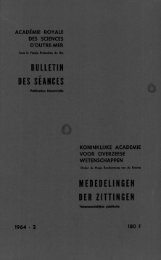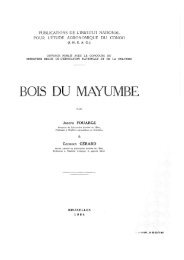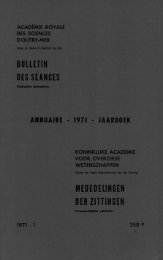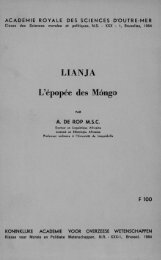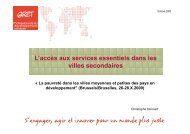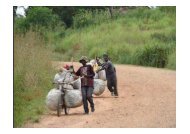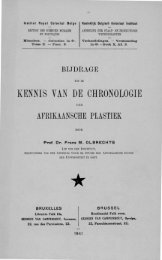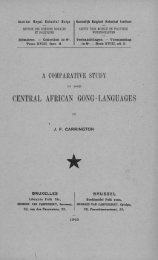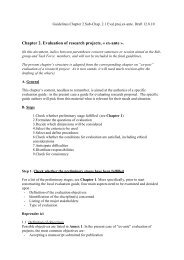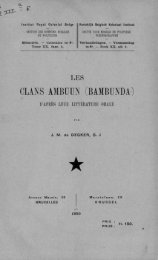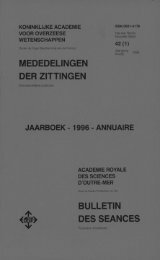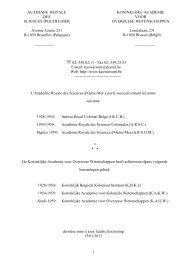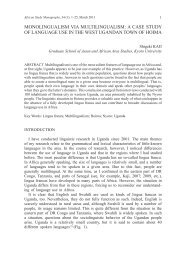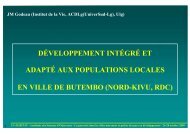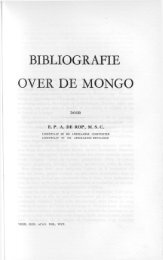(1986) n°2 - Royal Academy for Overseas Sciences
(1986) n°2 - Royal Academy for Overseas Sciences
(1986) n°2 - Royal Academy for Overseas Sciences
You also want an ePaper? Increase the reach of your titles
YUMPU automatically turns print PDFs into web optimized ePapers that Google loves.
— 112 —<br />
van het algemeen middelbaar onderwijs ten voordele van een ontwikkeling van de technische,<br />
beroeps-, landbouw- en normale vorming en het hoger onderwijs eveneens dient meer<br />
gediversifieerd te worden en meer studenten te ontvangen. De inrichtende machten van het<br />
onderwijs zijn de openbare diensten, de sector van de gemeenschappelijke eigendom en de<br />
privé-sector ; slechts het basis onderwijs verstrekt in de openbare scholen is gratis. Een zeer<br />
stricte hiërarchie wordt tussen de scholen vastgesteld volgens de kwaliteit van de vorming die<br />
zij geven (de rang bepaalt de middelen en het bezoldigingsniveau van het personeel) en de<br />
selectie bij de ingang in de beste scholen is bijzonder streng. Het middelbaar onderwijs van<br />
de hogere cyclus en het eigenlijke hoger onderwijs worden bezocht door betalende leerlingen,<br />
leerlingen van wie de studies gedragen worden door hun werkgever en door leerlingen die<br />
beurzen toegewezen kregen ofwel in functie van academische criteria (toegang tot de beste<br />
instellingen) ofwel in functie van verdiensten van sociale of beroepsaard of nog van politieke<br />
aard. De keuze van beroepsmogelijkheden op het einde van de studies is ontzettend afwisselend<br />
en alleen de beursstudenten gediplomeerd van de universiteiten of van de meest beroemde<br />
hogere instellingen beschikken over een werkelijke keuzemogelijkheid. Kontrakten van<br />
beperkte duur en hernieuwbaar en het wettigen van privé-initiatieven scheppen opnieuw een<br />
kategorie van zelfstandigen en vrije beroepen.<br />
Su m m a r y. — Education in the modernization programme of the People’s Republic of China.<br />
— The resolution of the Central Committee of the Chinese Communist Party dated 27 May<br />
1985 traces the lines of the re<strong>for</strong>m of regular full-time education in the light of trans<strong>for</strong>mations<br />
undertaken in all sectors of activity and all structures since 1977. The primary education of<br />
9 years is to made obligatory by the end of the twentieth century ; the common trunk of<br />
secondary general is abandoned to make place <strong>for</strong> a development of technical, professional,<br />
agricultural and normal <strong>for</strong>mation, and higher education itself must also be more diversified<br />
and take more students. The organisers of education are the public bodies, the sector of<br />
collective property and the private sector ; the only free education being primary education (9<br />
years) in the public network. A very strict hierarchy is established amongst the schools<br />
according to the quality of the education given (the ranking determining the means and the<br />
level of remuneration of the personnel) and the entrance selection <strong>for</strong> the best is particularly<br />
severe. Secondary education of the higher level and higher education itself are attended by<br />
fee-paying pupils, pupils whose studies are paid <strong>for</strong> by their employer and by pupils who have<br />
obtained bursaries granted either in function of academic criteria (access to the best establishments)<br />
or in function of other merits : social, professional or even political. The range of<br />
employment possibilities at the end of studies varies considerably and the only ones with a real<br />
choice are bursary-holders who have graduated from a university or the most renowned higher<br />
institutes. Renewable contracts of a determined duration and the legalizing of private initiatives<br />
recreate a category of self-employed and liberal professions.<br />
*<br />
* *<br />
Depuis 1978, la Chine populaire a repris le programme entamé dès 1949 en vue<br />
de ren<strong>for</strong>cer son économie, d’assurer la sécurité de son territoire et d’élever le niveau<br />
de ses techniques et de sa recherche. L’objectif final, toujours poursuivi, est d’assurer<br />
l’indépendance de la Chine, de la remettre sur un pied d’égalité avec les pays les plus<br />
développés.



